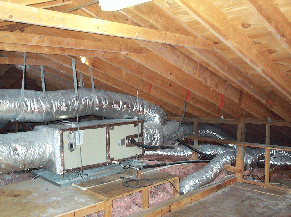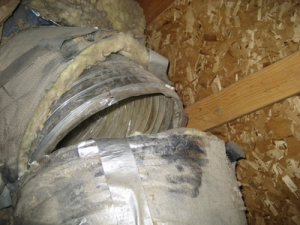If there’s nothing wrong with your air conditioner, but your electricity bill seems too high during those hot months, you may want to schedule an energy audit. During this process, we will thoroughly evaluate the energy efficiency of your house, and recommend the most cost-effective combination of upgrades.
If you’re deciding whether to repair or replace your AC, here are some things you should know.
Proper Unit Size
 We cannot overstate the importance of accurate unit sizing. Here are 3 example scenarios to demonstrate this point.
We cannot overstate the importance of accurate unit sizing. Here are 3 example scenarios to demonstrate this point.
Bad: Poor duct design, leaky building, over-sized HVAC to compensate
Result: very poor efficiency, uneven heating/cooling, poor comfort, loud system, poor airflow mixing, shortened system life
Sadly, this is by far the most common scenario, and the least energy efficient.
Bad: Air sealing and duct retrofits complete, but didn’t replace oversized HVAC
Result: marginal efficiency increase, but often still uncomfortable due to the now even more over-sized unit, which will cycle on/off frequently, create lot of noise, and may cause pressure problems. Airflow blasts into each room, the system shuts off and then the air immediately stratifies because the system’s airflow is no longer driving it to mix.
This is why we take a whole-house approach to energy efficiency.
Good: Air sealing and duct retrofits complete, engineered to deliver the ideal loads to each room, and properly (minimally) sized HVAC
Result: major efficiency gain, maximum comfort (quiet, consistent, even heating and cooling)
This is the goal. Besides the efficiency and comfort gain, having a properly sized unit increases the long-term durability and reliability of your system.
Duct Leakage
 The average California home has about 30% duct leakage. This may seem like a lot… and it is. Really, any number greater than 0% duct leakage should be unacceptable. Having sealed (and properly sized/designed) ducts will allow you to use a smaller, more efficient HVAC unit, will improve air quality and will reduce your home’s leakage even when the heating/cooling system is off. A leak in a duct is no different than a leak in the house.
The average California home has about 30% duct leakage. This may seem like a lot… and it is. Really, any number greater than 0% duct leakage should be unacceptable. Having sealed (and properly sized/designed) ducts will allow you to use a smaller, more efficient HVAC unit, will improve air quality and will reduce your home’s leakage even when the heating/cooling system is off. A leak in a duct is no different than a leak in the house.
Equally relevant is the quality of your duct engineering. We use manual J and D calculations to determine the ideal duct size, layout and air flow to each room, to maximize efficiency and comfort.
Air Flow
In addition to cooling your home, AC units also remove humidity from the air. In dry California, we want a relatively high flow rate across the AC coils so that minimal moisture is removed. The air is already dry enough here. Also, at low flow rates the AC system will waste energy attempting to remove moisture. For maximum efficiency in dry climates, aim for 500 CFM/ton, which is 500 cubic feet per minute for every ton of cooling (12,000 BTU/h or 3.5 kW).
Static Pressure
When designing or retrofitting a duct system, we must be aware of the static pressure. Static pressure is the measurable resistance to airflow attributed to: a) system over-sizing, b) poor duct sizing, c) over dampening of airflow, d) ducts that are not straight and taut, e) over filtering, f) supply registers that block a lot of air etc. Over long periods of time, high pressure can be very damaging to the system as it leads to more wear and tear. The average California home’s HVAC system static pressure exceeds the recommended maximum by 60%!
New, efficient, minimally sized AHUs (air handler units) combined with unrestrictive duct systems can exceed 5 CFM per watt, while keeping static pressure below 80% of the maximum. This is way above average, and yet, not that difficult to achieve for someone who designs and installs a system carefully. Hitting these numbers will save energy and reduce the wear and tear on your ducts.
Refrigerant
If you’re deciding whether to upgrade your air conditioner, find out what coolant it uses. If it’s R-22, then you probably have an older unit, and an upgrade would mean a big step up in efficiency.
 Furthermore, if your air conditioner uses R-22, you should be aware that this stuff is not environmentally friendly. It is an ozone killer and a powerful greenhouse gas. R-22 is gradually being replaced with R-410A. The type of refrigerant is also relevant in terms of maintenance and repair. You must ensure that the maintenance person is qualified to work with your type of refrigerant (don’t assume this is the case).
Furthermore, if your air conditioner uses R-22, you should be aware that this stuff is not environmentally friendly. It is an ozone killer and a powerful greenhouse gas. R-22 is gradually being replaced with R-410A. The type of refrigerant is also relevant in terms of maintenance and repair. You must ensure that the maintenance person is qualified to work with your type of refrigerant (don’t assume this is the case).
Design Trumps Power
We’d like to reiterate the importance of a whole-house approach to energy efficiency. If you replace your air conditioner but don’t change anything else, it may not be worth the investment, and could even make things worse. The efficiency rating of the unit itself is actually the least important factor in all this. True efficiency and comfort are achieved only when the entire system is designed to work together with a properly sized unit.
We get it, your AC is breaking or has broken and its hot. You want to replace it as quickly as possible. Be careful though, rushed HVAC work does not usually end well. What will happen is that you will call an HVAC guy, they will come out and replace your old AC with a new “high efficiency” AC that will likely be just as over-sized as the old one or more so. The high efficiency rating of the unit matters very little compared to the proper sizing. We’ve tested hundreds of houses and only a couple of times has the Furnace and AC been just about the right size. Every week we install 1.5 ton ACs to 2.5 ton ACs with a minimally sized furnaces or hydronic air handlers to replace original 4-5 ton ACs and large furnaces. The ducts are always replaced and redesigned, the home is always further sealed and insulated, and the improvement is always dramatic.
[dropshadowbox align=”none” effect=”lifted-both” width=”640px” height=”” background_color=”#ffffff” border_width=”1″ border_color=”#dddddd” ]For more information, call (925) 363-4498 or e-mail info@epbuilders.com to speak to a technician, or schedule an energy audit.[/dropshadowbox]

Thanks for the help with deciding if I should repair or replace my ac unit. My home has a pretty old unit, so it is in pretty bad shape, but I’m still not sure it is time to replace it. Thanks for the tip on checking the air flow in my home. I will be sure to check it and see how my unit is doing.
You have a lot of information here about air conditioners. I didn’t know most of this before, this is really interesting. I can see how design would trump power though, having a good design is always the better option.
You have a lot of information here about air conditioners. I didn’t know most of this before, this is really interesting. I can see how design would trump power though, having a good design is always the better option.
Reply
Definitely agree the design trumps power any day. We try to inform our customers of this best we can. Thanks for the article.
-Dave
This article makes me think if I should change my old air conditioner. Thanks for sharing this. This article is very informative.